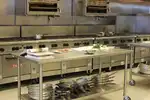The Future of the Quick Service Restaurant Industry- Fast Food Automat
Fast food automation is revolutionizing the way we order and prepare food, bringing efficiency and convenience to the industry. As Hunter S. Thompson aptly put it, fast food may be the only tangible thing left that connects us to the 20th century. In this digital age, automation is the future of the fast food industry.
Fast food has become a way of life for many people, providing a quick and convenient meal option in our fast-paced society. According to a study conducted by the National Restaurant Association, fast food sales reached $256 billion in the United States in 2020, making it a significant industry. However, with the increasing demand for convenience, traditional fast food experiences are becoming outdated, and fast food automation is stepping up to fill the gap.
In this article, we will take a closer look at the impact of fast food automation on the industry and society. We will explore the advantages of automation, the different types of fast food automation, the challenges associated with implementing automated systems, and the social impact of automation. Furthermore, we will discuss the future of fast food automation and how it is likely to continue to transform the industry.
History of Fast Food Automation- Early Years
The concept of fast food automation has been around for decades, with the first recorded use of self-service machines dating back to the early 1900s. However, it wasn't until the 1970s that fast food automation became mainstream. In 1973, McDonald's introduced the first automated grill, which replaced the need for manual flipping of burgers. This technology reduced the need for skilled cooks, which helped to increase efficiency and speed up service.
In the 1980s, the introduction of point-of-sale (POS) systems in fast food restaurants began to take hold. POS systems allowed for quicker ordering and improved inventory management. By the 1990s, touch screen kiosks were introduced, providing customers with the ability to place their own orders, further improving efficiency and reducing wait times.
The early 2000s saw the introduction of mobile ordering and payment systems, allowing customers to place orders and pay for their meals through their mobile devices. This innovation has provided customers with an even more convenient way to order and pay for their food, allowing them to skip the lines altogether.
In recent years, automation has taken on an even more significant role in the fast food industry. Kiosks and self-service machines have become commonplace, and some restaurants have even begun testing fully automated kitchen equipment. With the integration of artificial intelligence and robotics, the future of fast food automation seems limitless.

Let’s Start Digitalizing Your Signage Today!
Plum Digital Signage:- Simple & Clean
Advantages of Fast Food Automation
The benefits of fast food automation cannot be overstated. The speed at which customers can now place and receive their orders has been significantly improved, making the fast food experience much more efficient. With systems that are faster than even a microwave meal, customers can place their orders and receive their food in a matter of minutes. This not only saves time for the customer, but it also allows for more customers to be served in a shorter amount of time.
One of the most significant advantages of fast food automation is the elimination of long lines. With self-service kiosks and mobile ordering systems, customers can now place their orders without having to wait in long lines, which can be frustrating and time-consuming. This improvement in service has made the fast food experience much more enjoyable for customers.
Furthermore, automated systems have also improved order accuracy. Customers can input their orders directly into the system, eliminating any miscommunication that may have occurred when placing orders with a human employee. This has resulted in fewer mistakes and fewer complaints, leading to higher customer satisfaction.
The efficiency of fast food automation has also translated into benefits for the restaurants themselves. With faster order times, restaurants can serve more customers in a shorter amount of time, increasing their revenue potential. Additionally, automated systems have allowed for more efficient inventory management, reducing waste and saving money for the restaurant.
Types of Fast Food Automation
There are various types of fast food automation, including kiosks and self-service machines, mobile ordering and payment systems, and automated kitchen equipment. Kiosks and self-service machines are changing the face of fast food restaurants by providing a new way for customers to order their meals. Mobile ordering and payment systems are also increasing convenience and accessibility for customers. Automated kitchen equipment is bringing a new meaning to the phrase "behind the scenes" by automating the cooking and preparation process, allowing for faster and more efficient food preparation
Kiosks and Self-Service Machines
The rise of kiosks and self-service machines in fast food restaurants has transformed the way customers place their orders. Instead of waiting in long lines, customers can use these machines to input their orders directly into the system, reducing wait times and improving order accuracy. Kiosks and self-service machines also offer customers the flexibility to customize their orders, as they can easily add or remove ingredients to their meals. This type of automation has also allowed fast food restaurants to operate with a smaller workforce, reducing labor costs while increasing efficiency.

Reduce Your Labor Cost Now
Simplify Employee Time and Attendance with Plum Clock
Mobile Ordering and Payment Systems
The convenience of mobile devices has paved the way for the development of mobile ordering and payment systems in the fast food industry. With just a few taps on their smartphones, customers can place their orders and pay for their meals without even leaving their seats. This type of automation not only saves time, but it also eliminates the need for customers to handle cash, reducing the risk of germ transmission. Mobile ordering and payment systems have also enabled fast food restaurants to collect valuable data on customer behavior and preferences, allowing them to tailor their offerings and marketing strategies accordingly.
Automated Kitchen Equipment
Behind every fast food restaurant, there is a complex network of automated kitchen equipment that makes the food preparation process faster and more efficient. Automated kitchen equipment includes cooking equipment, such as fryers and grills, as well as food preparation equipment, such as mixers and choppers. This type of automation has reduced the need for manual labor, enabling fast food restaurants to streamline their operations and increase productivity. Automated kitchen equipment also ensures consistency in food quality, as machines can precisely measure and cook ingredients to meet specific standards.
Delivery and order fulfillment automation
Delivery and order fulfillment automation is a rapidly growing area of fast food automation. With the increasing popularity of food delivery services, many fast food establishments are turning to robots and other automated systems to fulfill orders and deliver food to customers.
One example of delivery and order fulfillment automation is the use of delivery robots. Companies like Domino's and Amazon have already started using delivery robots to bring food and other products directly to customers' doors. These robots use GPS technology to navigate streets and sidewalks, making deliveries faster and more efficient. They are also equipped with sensors and cameras to ensure safe navigation and delivery.
In addition to delivery robots, there are also automated order fulfillment systems that use robots to prepare and package food orders. These systems are designed to streamline the food preparation process and reduce wait times for customers. For example, Zume Pizza, a startup based in Silicon Valley, uses robots to prepare and cook pizza. The company's pizza-making robots can assemble and cook a pizza in less than three minutes, making it a popular option for customers who are short on time.
Challenges of Fast Food Automation
Fast food automation, while advantageous, is not without its challenges. One of the most significant obstacles that come with implementing these systems is the initial cost of installation. The expense can be substantial for smaller businesses that are looking to adopt the technology. Furthermore, there may be additional costs associated with upgrading existing infrastructure to support these automated systems. However, many businesses are finding that the long-term benefits of automation make the investment worthwhile.
Maintenance and repair are also critical aspects of ensuring that the automated systems run smoothly. Like any other technology, these systems require maintenance to keep them functioning correctly. In some cases, repairs may be necessary to fix any malfunctions or technical glitches that arise. The responsibility of maintenance and repairs can fall on the business owners or be outsourced to third-party providers.
Employee training is another crucial factor that businesses need to consider when implementing fast food automation. The employees who will be working with these systems must receive adequate training to ensure that they are using the technology correctly. The training process can be compared to teaching a robot how to dance, as it requires patience, diligence, and thoroughness. However, once employees are trained, they can use these systems to provide faster and more efficient service to customers.
While there are some challenges associated with fast food automation, the benefits far outweigh the costs. By adopting automated systems, businesses can reduce wait times, increase order accuracy, and streamline their operations. In the end, the investment in automation can lead to improved customer satisfaction, increased sales, and higher profits.
Social Impact of Fast Food Automation
Fast food automation has undoubtedly had a significant impact on society, particularly in terms of customer satisfaction. By making the fast food experience more efficient and convenient, fast food automation has revolutionized the way people interact with fast food establishments. The speed at which customers can place their orders has drastically improved, and they no longer have to endure long lines or wait times. In addition, the increased accessibility and convenience provided by fast food automation have made it easier for people with disabilities or mobility issues to enjoy fast food, which is a crucial step towards achieving greater inclusivity in society.
However, the implementation of fast food automation has also raised concerns about job displacement. As more tasks become automated, there is a risk that many fast food employees may lose their jobs. This has sparked debates about the future of work, particularly in industries that rely heavily on low-skilled labor. It is essential to recognize these concerns and address them proactively to ensure that everyone has the opportunity to thrive in the changing economy. This can include providing training and education programs to help employees develop new skills and transition to new roles within the industry.
Furthermore, fast food automation has also highlighted the importance of striking a balance between technological advancements and human interaction. While automation can improve efficiency and convenience, it can also lead to a loss of personal interaction with customers. The human touch is still vital in providing excellent customer service and fostering positive relationships with customers. Thus, it is crucial to ensure that automation is used in a way that complements human interactions rather than replaces them.
The Future of Fast Food Automation
Fast food automation is rapidly transforming the industry, with the integration of AI and robotics promising to enhance the customer experience and improve efficiency. AI technology can predict customers' preferences based on their past orders, leading to faster and more accurate recommendations. The use of AI also enables better inventory management, ensuring popular menu items are always in stock. This technology is poised to provide a more personalized and efficient experience for customers, which will be a crucial competitive advantage for fast food chains.
In addition to AI, robotics technology has been integrated into the fast food industry, automating food preparation and assembly. Robotic equipment working alongside human staff can increase efficiency and reduce errors. With consistent quality and portion control, customers can expect a better overall experience. Fast food chains can make the most of this technology to increase productivity and reduce labor costs.
The integration of fast food automation is not limited to traditional fast food establishments. It can be applied to various types of restaurants and cafes to make the process more efficient and seamless for customers. For example, in the fast-paced drive-thru environment, robotic technology can be utilized to prepare and serve food more quickly, reducing wait times and improving customer satisfaction. Furthermore, automation in the kitchen can help with managing labor shortages, which is a critical issue that the industry is currently facing.
The future of fast food automation is bright, and the possibilities are endless. It is expected to play a significant role in transforming the industry in the coming years. With AI and robotics technology, fast food chains can streamline their operations, provide faster and more efficient service, and offer a personalized experience for customers. However, it is essential to consider the cost and complexity of implementing these systems and to ensure that all employees are adequately trained. As the industry continues to evolve, fast food chains that embrace technology and automation will have a competitive advantage in meeting customers' evolving expectations.
How Fast Food Automation is Changing the Industry
Fast food automation has given rise to a new era of convenience and efficiency in the fast food industry. As the use of technology becomes more prevalent in our daily lives, customers have come to expect a seamless experience when it comes to ordering and receiving their fast food. Companies that embrace fast food automation are finding that they can provide a faster, more accurate, and more enjoyable experience for their customers.
Automated systems have enabled fast food restaurants to improve the accuracy and speed of their order fulfillment. By removing the need for manual order taking, automated systems reduce the risk of errors and miscommunication between customers and staff. They also help reduce waiting times, enabling customers to receive their orders more quickly.
Fast food automation has also allowed companies to streamline their operations and better manage their resources. By automating certain tasks, such as food preparation and inventory management, companies can operate more efficiently, reducing waste and lowering costs. This, in turn, can result in lower prices for customers.
The impact of fast food automation on the industry is significant, and it is not limited to just the ordering and preparation of food. As automation continues to evolve, it will likely have a profound effect on the entire supply chain, from production to delivery. As a result, companies that embrace fast food automation will be better positioned to adapt to the changing demands of the industry and remain competitive in a rapidly evolving marketplace.
Fast food automation is changing the industry by providing a more efficient and enjoyable experience for customers, while also helping companies reduce costs and streamline operations. While there are concerns about job displacement and implementation costs, the benefits of fast food automation are clear. As technology continues to evolve, it is likely that automation will become an increasingly important part of the fast food industry, helping companies to stay ahead of the curve and meet the changing demands of their customers.
Case Study- Fast Food Automation at White Castle
As fast food chains continue to face labor shortages and an increasing need for efficiency, they are turning to automation to help fill the gaps. White Castle, the popular fast food chain known for its sliders, has been at the forefront of this trend, partnering with Miso Robotics to introduce automated kitchen equipment in their restaurants.
One of the most significant challenges that White Castle faced was the labor shortage that affected many fast-food chains. With fewer workers available, the restaurant had to find a way to maintain its high level of service and food quality. The solution was to automate certain aspects of their kitchen, starting with the fry station.
White Castle worked with Miso Robotics to develop an automated fry cook, which they named "Flippy." Flippy is a robotic arm that uses artificial intelligence to monitor the cooking process and ensure that each batch of fries is cooked to perfection. The technology also allows for more efficient cooking, as Flippy can cook multiple batches simultaneously, reducing wait times for customers.
The integration of Flippy into White Castle's kitchen has been a resounding success. The automated fry station has allowed for faster service and increased order accuracy, leading to improved customer satisfaction. The success of the pilot program has led to plans for further automation, including the addition of Flippy to other kitchen stations and the integration of other automated systems, such as order-taking kiosks.
However, the introduction of fast food automation has not been without its challenges. While the technology has improved efficiency and customer satisfaction, it has also raised concerns about job displacement. White Castle has addressed these concerns by retraining employees to work alongside the new technology and providing them with new opportunities for advancement within the company.
Overall, the partnership between White Castle and Miso Robotics is a clear example of how fast food automation is changing the industry. By embracing new technologies, fast food chains can improve efficiency, maintain food quality, and provide a better experience for their customers. As the industry continues to evolve, it will be interesting to see how other fast food chains adopt automation and integrate it into their operations.
Future of the Quick Service Industry- Fast Food Automatation
Fast food automation is revolutionizing the quick service industry, providing numerous benefits that include increased efficiency, accuracy, and convenience for both customers and employees. Although there are some challenges such as the cost of installation and employee training, fast food automation's advantages outweigh them. As AI and robotics continue to evolve, the possibilities for fast food automation are endless. Technology is likely to become even more prevalent, and companies must embrace these changes to remain competitive. In this ever-changing industry, it is crucial to address concerns about job displacement and ensure that everyone has equal opportunities to thrive in the changing economy.
As fast food automation changes the industry, it is essential to emphasize the importance of maintaining consistent quality and safety, especially when preparing popular menu items such as French fries. Fast food companies should also consider the implications of their terms of use regarding data privacy and the protection of customer information. Overall, fast food automation's impact is undeniable, and it is a significant factor in shaping the future of the quick service industry. With proper implementation and consideration for its effects, fast food automation can revolutionize the industry and provide a better experience for both customers and employees.

Simplicity at its Best
Maximize Your Sales with Plum POS




































